|
Look inside the lid of the stylish vaulted cases provided with their
flutes by Rudall & Rose and you'll find an interesting
certificate. It reads:
"Rudall & Rose, having discovered that Flutes are
offered for Sale bearing their names & addrefs, which have not
been made by them, are determined to guard the Public against such
imposition, by not sending out in future any Flute from their
Manufactory without this Notice affixed to the top of the Case."
The certificate is signed:
George Rudall, John, M, Rose
and, in later days, carries the date. Here's an
example of such a certificate, from a Bb flute in the Royal Northern
College of Music in Manchester.
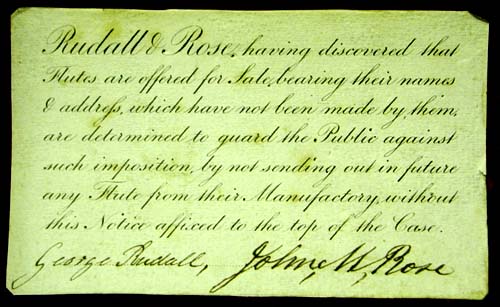
Well, is it for real? Were there really other makers
passing off their flutes as having been made by the illustrious firm of
Rudall and Rose? Or was it just clever merchandising - pretend your
product is so good that others are imitating it? We think we now
have some real live evidence to put before you ....
Contemporary evidence
But before we look at our smoking gun, let's look for
corroborating evidence from writers of around that time. From
Lindsay's "A Few Practical Hints"
(London, 1829), we find that the practice of faking flutes by well-known
makers was well documented:
"But incapacity is not the whole "head and front of their offending," for these sort of gentry often go a step
further, and having no reputation of their own, they make free to borrow
that of various respectable and established maker's, by stamping their names upon
the trash vamped up in the manner we have described, and so doubly impose upon the
unwary.
In this way, the names of Messrs. CLEMENTI
and Co., Messrs. MONZANI
and Co., Mr. NICHOLSON, and Mr.
POTTER have been successively used by the unprincipled and designing, sometimes either omitting, adding, or altering a single letter in the
orthography of the name, so as to evade the operation of the Law, in the event of
the fraud being detected. Indeed to such an extent have these nefarious practices been carried on, with reference to the last mentioned individual, in particular, that they must of necessity have subjected him to much mortification and loss: there is scarcely
in town a shop window of the description alluded to, which has not an abundance
of " Potter's Flutes" exposed for sale, not one in six of which are legitimate, but known amongst the
flute-making trade by the unequivocal denomination of "bastard Potters."
The same system has been followed in regard to Mr.
DROUET'S manufacture, and the comparatively inconsiderable number of Flutes, which his short sojourn in this country enabled him to finish, has, even on a moderate computation, been thus surreptitiously increased five-fold, for notwithstanding all
the "fine toned Flutes by Drouet," which are ticketed up in every street, scarcely a
genuine DROUET Flute is now to be met with."
But more than that, Lindsay reveals the practice of foisting badly-made
flutes off as the work of others. He precedes the above with:
"It is a fact that no
wooden, musical instrument can be expected to prove perfect, unless
manufactured from well-seasoned materials; but, in despite of this
truth, it is notorious that nine-tenths of those instruments which are
daily exhibited in the Sale-shop window are made by needy workmen,
without credit, who have neither capital to carry into the market to
purchase a stock of material, a good model to work from, nor yet
character as tradesmen at stake. The consequence is that a single
log of wood is often purchased on one day, is sawn into lengths the
next, and subsequently turned, bored, mounted with what is called
silver, and otherwise metamorphosed, in the course of the same week,
into an apparently elegant Flute, - but without tone, without
intonation, "sans everything," in short, but external
appearance to recommend it. This Flute, with all its faults and
imperfections on its head is then sold to the Pawnbroker, or Salesman,
for whatever price it will fetch, and immediately offered to the public
as an instrument of the very first order, an article of undoubted vertú!"
Other writers around that time have made the same and similar
claims But claims are one thing - it would be nice to see a real
live example (pauses for drum roll) ....
The Peoples Exhibit No 1
The flute below was turned up in late 2002 in a second-hand store in
Vancouver, Canada, by my good friend and research colleague Adrian
Duncan. Several weeks later it landed on my doorstep. It's
currently "assisting authorities with their
enquiries".

Compared to what, m'Lord?
It has to be said that Rudall & Rose have not made it easy for us
to spot a fraud. Their output, some 5800 flutes before they became
Rudall Rose & Co, is enormously varied in every conceivable
feature. We'll be relying on evidence thrown up in our Rudall, Rose
or Carte Models Study, but we have to concede that virtually every flute
so far investigated is different in at least some way from every other.
Old Fake or Crummy Repair?
The flute in question is in bad shape. Only one key remains on
the body section and most blocks are not integral with the body.
What is original work and what is more recent? We need to tread
cautiously...
How to proceed?
Our approach will be to look at every detail of the flute, comparing it
to what we might expect of an authentic Rudall. We'll certainly
point to the things that we find anomalous, before trying to
determine if the flute is authentic. If you know better about a
point we raise, we want to hear from you. We'll work our way down
the flute, bringing every matter of interest to your attention.
THE HEAD
The cap
Starting at the top we meet the cap. Now the cap plays no part in
the acoustics of the instrument (apart from being our way to move the
stopper). It's essentially a functional item with some decorative
properties. It seems to me that, at 11.2mm, this cap is thicker than the
usual Rudall cap and employs different decoration (see below).
|
The Indicator
The stopper shaft protrudes through the cap and acts as an indicator
of stopper position. The classic Rudall indicator is a ball,
sitting astride a sloping podium. The ball on this indicator is
not round, nor is the podium sloping.
|
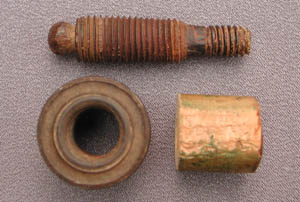 |
The Stopper
Further, the shaft would normally have a flange at the back of the
cork, and the threaded section that screws into the cork would be
tapered. The cork would normally be about twice this length.
The shaft varies between 12.3 and 11.7mm (suggesting it is
hand-chased and so probably from the period), with the section
entering the cork about 8.3mm. Rudall's seemed to go more often
for a shaft about 11mm.
The thread pitch though is interesting - it appears to be 17 TPI.
Not a common pitch.
The top ring
This is probably a poor repair. It is porous on the outside and perforated on the
inside. There are none of the common Rudall thread
grooves on the wood beneath.
The head
The head, at 133mm, is very short, compared to the average 160mm,
and minimum 147mm thrown up in the RRC study. Why waste wood if
you're doing a fake? Most of the "missing" wood is
from above the embouchure.
Embouchure
The embouchure hole is crudely cut. The hole in the metal liner
is substantially bigger than the hole in the wood, and not set well with
it.
Lower Ring
Normally, on a Rudall, the two rings between head and barrel take the
form of rings with a flange on the visible side. This is just a plain ring.
Male slide gap
The gap in the end of the head which accepts the protruding barrel slide is
not concentric with either the ring or liner. Uncharacteristically
shoddy work.
Liner
The head liner is of yellow brass, apparently soft soldered, with the
thin plating completely worn away.
THE BARREL
|
Barrel slide
It's thin yellow brass, with no sign of the usual decorative
sleeve. The leading edge has been compressed to procure
air-tightness. The lower end protrudes well into socket, rather
than being rolled to prevent withdrawal, to the extent that a 1mm gap
remains when the body tenon is pushed home. |
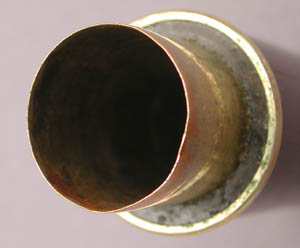 |
Top ring
This ring is more narrow than the matching adjacent ring on the head, protrudes more
and again has no flange.
No Name
The barrel on a Rudall flute normally carries the maker's name.
Bottom ring
Normally the widest ring; on this flute is of intermediate size.
Again, there are no grooves in the underlying wood.
THE Left Hand Section
The Maker's Mark
Very interesting. RUDAI L & ROSE, with the final L in RUDAI L excessively spaced,
as if the penultimate letter was also L. The final L also a little
twisted.
|
| ROSE is drooping; LONDON rising.
No Address. No Serial
Number.
|
 |
Top block
Normally one rounded bead serves as both hinge block for Bb and guide
block for upper c; only the upper half of the c guide block remains.
It appears crudely formed.
|
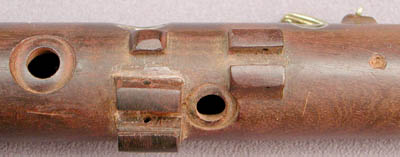 |
A massive rectilinear hinge block has been grafted on for Bb. It
is crude and misshapen in every dimension, surface and edge. Its
slot is wide, wedge-shaped and rough, and extends well below the
surface. It is probably a very bad repair. C Hinge Block
The C Hinge block is integral with the body, but again poorly
formed. No striker plate for the spring.
The C Cork Dot
While cork dot silencers are common on Rudalls, the Long C doesn't
normally have one. The cork dot on this flute (visible at the right
of the image above) is very badly formed.
G# Block and Key
|
|
The G# block is also integral with the body, but unusual in that both
of its ends are curved, whereas on most flutes of the period the lower end
cuts tangentially back to the side of the body. The key (the only
body key left) is unusual too in that it is slightly asymmetric, with a
cutaway to reduce interference with the third finger. It looks a little
apologetic though! |
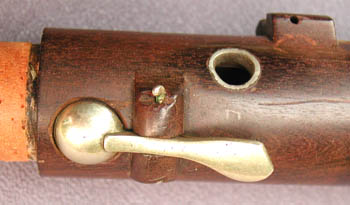 |
A small chip from the inner edge of the G# seat probably occurred at the time
of making. The hinge pin shows drawplate marks and has been cut off
quite crudely. The key is cast adequately but the business end of
the spring is poorly finished. Again no striker plate.
THE RIGHT HAND SECTION
The ring
Of more normal dimensions, but again no grooves in the underlying wood.
The Split
A wide split has occurred, extending 50mm or more down the
section. This suggests substantial shrinkage of the wood, with the
ring left providing no support. There appear to be two other lesser
splits to the socket area. Such splitting in unlined sections is
rare in flutes made from adequately seasoned timbers.
The socket
Something funny about this socket - it's 4mm deeper than the tenon is
long. Very sloppy, very uncharacteristic.
The Maker's Mark
A bit obscured by the rough work of the subsequent repairer, but
essentially the same as the marks on the upper body and foot. Again
definitely "RUDAI L".
|
Blocks
The blocks for both Short and Long F have been added to the flute, but when
is impossible to establish. Both jobs display the worst possible
workmanship. There are traces of a former guide block for Long
F.
And signs of a careless cut with a dovetail saw on the Short F...
|
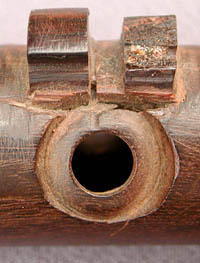 |
THE FOOT
The Foot, perhaps the hardest part of a flute to do well, is actually
in better shape and is more well made than the rest of the
instrument. None-the-less, there are still issues to consider:
The Socket
|
|
As above, the socket has a wide split, suggesting shrinking wood, and
the socket is a little deeper than the tenon is long. The ring is
better fitted however, and there is a thread groove in the wood under
it. |
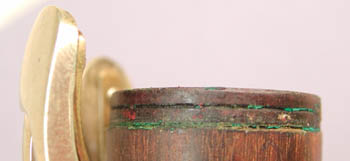 |
Eb Key
The Eb key conforms to the normal Rudall outline, but is mounted
without a striker plate for the spring. The slot is reasonably well
cut and pin installed well. The key seat is countersunk and cut
better than the remaining seats.
The C & C# touch shafts
These are well enough made, but seem a little wide in the touch area
for Rudall's. Because the C and C# holes were not set in line, the
two shafts do not run quite parallel. Again there are no striker
plates for the springs to bear upon.
The Pewter Plugs
|
|
These close onto round horizontally- mounted plates, apparently held
in place by adhesive. Rudall plates are usually square, mounted at
an angle and secured with tiny screws. Closing is not great.
Neither is opening. The lower plug does not open far enough. |
 |
Maker's Mark
The final L in RUDAI L excessively spaced and twisted, ROSE
drooping. LONDON horizontal.
General Matters
In addition to the specific matters above, these general matters need
explanation:
Timber
The timber could be cocus. It appears to have been stained
darker, but most of the staining has been removed during later work.
The finish is poor with many visible file, chisel and sanding marks, but
it is impossible to determine which are original and which are subsequent
abuse.
Nickel Silver
Nickel silver was not so common in the Rudall & Rose period.
It probably is explained by Lindsay's comment "mounted with what is called
silver". It would seem consistent with a fake.
Hole Liners
The liners on the six finger holes are not rings set in as usual but tubes within the holes.
The tubes
appear to be pewter - the material is certainly softer than silver and
more grey. The tubes on holes 1 & 2 are not flush with the
surface of the wood. The tube on hole 2 projects into bore, while
the tubes on the other holes do not make
it to the bore, leaving a rather nasty surprise for air molecules that
might have wanted to exit there.
Key seats
The key seats are domed, rather than funnel-shaped (for purse-pads) or conical (for
card-backed pads). The holes not always concentric with seats.
It's rough work.
Striker plates
None of the keys have striker plates to take the spring load.
This is unusual; indeed flutes in the Rudall & Rose period were
commonly fitted with double springs (see Rudall & Rose No 519).
Cork Dots
On a regular Rudall, you might expect to find cork dot silencers under
the Bb, G# and Short F keys, but certainly not under the upper C, long F
or foot keys. On this flute only upper C has a dot, and it very
badly formed.
The Name Stamps
Perhaps the most damning evidence. "RUDALL" spelt
"RUDAI L". Recall Lindsay's comment: "sometimes either omitting, adding, or altering a single letter in the
orthography of the name, so as to evade the operation of the Law, in the event of
the fraud being detected".
The same stamp appearing in three places (normally Rudalls have a different
stamp on the upper body). No address (why tempt fate by telling
the owner where to bring the flute for service!). No serial number
(again to avoid embarrassment when Mr. Rudall appears in court with the
factory records).
Best Match with a Known Rudall
So is it like any Rudall we've ever seen? With some
reservations (particularly in terms of quality), yes. The best
match so far is R&R No 5047, No 592 in the Edinburgh
University Collection of Musical Instruments. Firstly, an exaggerated
image of the bore:
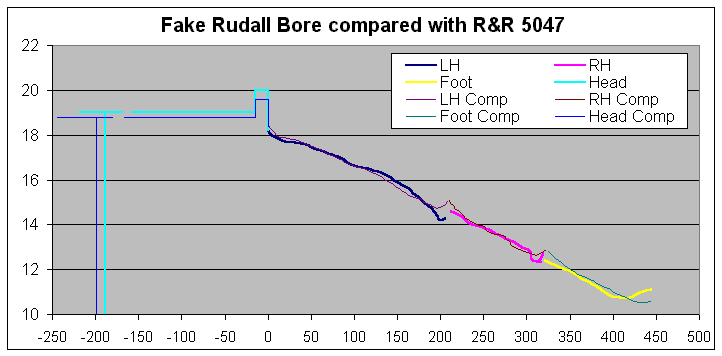
And the size and position of holes:
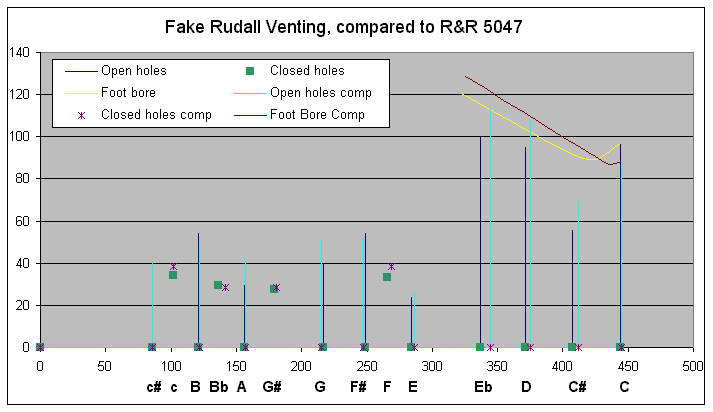
There are clear differences certainly, but probably relatively
insignificant in performance terms. We haven't got as far as
testing this flute yet (you've seen the condition it's in!) but I would
expect it to perform well if tidied up.
The apprentice theory
So how did this flute come about? One possibility to be
considered is that it actually came from the Rudall works - either as a
training exercise for an apprentice or from an enterprising workman
working through his lunch hour. But the blatantly fraudulent
maker's mark blows that theory out of the water.
The conclusion
I think the evidence is overwhelming - this is a fake! What a
wonderful thing to find - clear evidence that Rudalls (and presumably
other flutes) were being faked and that Lindsay wasn't just making this
stuff up.
Despite my confidence, don't be bullied. If you feel you can
poke holes in the evidence, or conversely if you can spot stuff I've
missed, get in contact.
Acknowledgement
Thanks to my good friend and colleague, Adrian Duncan, in Vancouver
Canada for finding this little number, entrusting it to our deliberations
and permitting this publication.
|
|
Return to McGee Flutes
Contents Page Created:1 February
2003 |
|